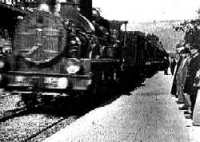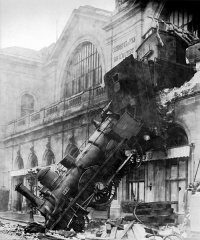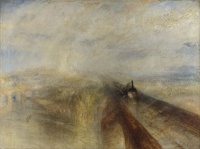Rail transport
From The Art and Popular Culture Encyclopedia
| Revision as of 18:24, 7 July 2022 Jahsonic (Talk | contribs) ← Previous diff |
Revision as of 18:28, 7 July 2022 Jahsonic (Talk | contribs) Next diff → |
||
| Line 10: | Line 10: | ||
| {{Template}} | {{Template}} | ||
| - | # A [[line]] of connected [[car]]s or [[carriage]]s pushed or pulled by one or more [[locomotive]]s, especially a [[railroad]] train which travels on a set of [[track]]s. | + | '''Rail transport''' (also known as '''train transport''') is a means of [[transport]] that transfers passengers and goods on wheeled [[vehicle]]s running on rails, which are located on [[Track (rail transport)|tracks]]. In contrast to [[road transport]], where the vehicles run on a prepared flat surface, rail vehicles ([[rolling stock]]) are directionally guided by the tracks on which they run. Tracks usually consist of [[steel]] rails, installed on [[Railroad tie|sleepers]] (ties) set in [[track ballast|ballast]], on which the rolling stock, usually fitted with metal wheels, moves. Other variations are also possible, such as "slab track", in which the rails are fastened to a concrete foundation resting on a prepared subsurface. |
| - | #: ''We rode the '''train''' to Mumbai.'' | + | |
| - | # A [[group]] of animals, vehicles, or people that [[follow]] one another in a [[line]], such as a wagon train; a [[caravan]] or [[procession]]. | + | Rolling stock in a rail transport system generally encounters lower [[friction|frictional resistance]] than rubber-tyred road vehicles, so passenger and freight cars (carriages and wagons) can be coupled into longer [[train]]s. The [[rail transport operations|operation]] is carried out by a [[railway company]], providing transport between [[train station]]s or freight customer facilities. Power is provided by [[locomotive]]s which either draw [[electric power]] from a [[railway electrification system]] or produce their own power, usually by [[diesel engine]]s or, historically, [[steam locomotive|steam]] engines. Most tracks are accompanied by a [[railway signaling|signalling system]]. Railways are a safe land transport system when compared to other forms of transport. Railway transport is capable of high levels of passenger and cargo utilisation and energy efficiency, but is often less flexible and more [[capital (economics)|capital]]-intensive than road transport, when lower traffic levels are considered. |
| - | #: ''Our party formed a '''train''' at the funeral parlor before departing for the burial.'' | + | |
| - | # A [[sequence]] of events or ideas which are interconnected; a train of events or a train of thought. | + | The oldest known, man/animal-hauled railways date back to the 6th century BC in [[Corinth]], [[Greece]]. Rail transport then commenced in mid 16th century in [[Germany]] in the form of horse-powered [[funicular]]s and [[wagonway]]s. Modern rail transport commenced with the British development of the [[steam locomotive]] in Merthyr Tydfil when Richard Trevithick ran a steam locomotive and loaded wagons between Penydarren Ironworks and Abercynon in 1802. Thus the [[Rail transport in Great Britain|railway system in Great Britain]] is the oldest in the world. Built by [[George Stephenson]] and his son [[Robert Stephenson|Robert]]'s company [[Robert Stephenson and Company]], the [[Locomotion No. 1|''Locomotion'' No. 1]] is the first steam locomotive to carry passengers on a public rail line, the [[Stockton and Darlington Railway]] in 1825. George Stephenson also built the first public inter-city railway line in the world to use only the steam locomotives, the [[Liverpool and Manchester Railway]] which [[Opening of the Liverpool and Manchester Railway|opened in 1830]]. With steam engines, one could construct mainline railways, which were a key component of the [[Industrial Revolution]]. Also, railways reduced the costs of [[shipping]], and allowed for fewer lost goods, compared with water transport, which faced occasional sinking of ships. The change from [[canals]] to railways allowed for "national markets" in which prices varied very little from city to city. The spread of the railway network and the use of railway timetables, led to the standardisation of time (railway time) in Britain based on Greenwich Mean Time. Prior to this, major towns and cities varied their local time relative to GMT. The invention and development of the railway in the United Kingdom was one of the most important technological inventions of the 19th century. The world's first underground railway, the [[Metropolitan Railway]] (part of the [[London Underground]]), opened in 1863. |
| - | # A series of electrical pulses. | + | |
| - | # A set of interconnected [[mechanical]] parts like the drive train of a car. | + | In the 1880s, [[railway electrification system|electrified]] trains were introduced, leading to electrification of tramways and rapid transit systems. Starting during the 1940s, the non-electrified railways in most countries had their steam locomotives replaced by [[diesel fuel|diesel]]-electric locomotives, with the process being almost complete by the 2000s. During the 1960s, electrified [[high-speed rail|high-speed railway systems]] were introduced in [[Japan]] and later in some other countries. Many countries are in the process of replacing diesel locomotives with electric locomotives, mainly due to environmental concerns, a notable example being [[Switzerland]], which has completely electrified its network. Other forms of guided ground transport outside the traditional railway definitions, such as [[monorail]] or [[maglev]], have been tried but have seen limited use. |
| - | # That which is [[draw]]n along, like the part of a [[gown]] which trails behind the wearer. | + | |
| - | #: ''The '''train''' of her bridal gown caught on a nail.'' | + | Following a decline after [[World War II]] due to competition from cars and aeroplanes, rail transport has had a revival in recent decades due to road congestion and rising fuel prices, as well as governments [[rail subsidies|investing in rail]] as a means of reducing [[CO2 emissions|CO<sub>2</sub> emissions]] in the context of concerns about [[global warming]]. |
| <gallery> | <gallery> | ||
Revision as of 18:28, 7 July 2022

|
"By the railway space is annihilated, and only time remains. [...] In three hours and a half one can now go to Orleans, in the same time to Rouen. What will it be when the lines to Belgium and Germany shall be finished and connected with the railways of those countries? I seem to see the mountains and forests of every country coming to Paris. I smell the perfume of German lime-trees; the billows of the North Sea are bounding and roaring before my door."--Heinrich Heine, FRENCH AFFAIRS LETTERS FROM PARIS, VOLUME II, LUTETIA |
|
Related e |
|
Featured: |
Rail transport (also known as train transport) is a means of transport that transfers passengers and goods on wheeled vehicles running on rails, which are located on tracks. In contrast to road transport, where the vehicles run on a prepared flat surface, rail vehicles (rolling stock) are directionally guided by the tracks on which they run. Tracks usually consist of steel rails, installed on sleepers (ties) set in ballast, on which the rolling stock, usually fitted with metal wheels, moves. Other variations are also possible, such as "slab track", in which the rails are fastened to a concrete foundation resting on a prepared subsurface.
Rolling stock in a rail transport system generally encounters lower frictional resistance than rubber-tyred road vehicles, so passenger and freight cars (carriages and wagons) can be coupled into longer trains. The operation is carried out by a railway company, providing transport between train stations or freight customer facilities. Power is provided by locomotives which either draw electric power from a railway electrification system or produce their own power, usually by diesel engines or, historically, steam engines. Most tracks are accompanied by a signalling system. Railways are a safe land transport system when compared to other forms of transport. Railway transport is capable of high levels of passenger and cargo utilisation and energy efficiency, but is often less flexible and more capital-intensive than road transport, when lower traffic levels are considered.
The oldest known, man/animal-hauled railways date back to the 6th century BC in Corinth, Greece. Rail transport then commenced in mid 16th century in Germany in the form of horse-powered funiculars and wagonways. Modern rail transport commenced with the British development of the steam locomotive in Merthyr Tydfil when Richard Trevithick ran a steam locomotive and loaded wagons between Penydarren Ironworks and Abercynon in 1802. Thus the railway system in Great Britain is the oldest in the world. Built by George Stephenson and his son Robert's company Robert Stephenson and Company, the Locomotion No. 1 is the first steam locomotive to carry passengers on a public rail line, the Stockton and Darlington Railway in 1825. George Stephenson also built the first public inter-city railway line in the world to use only the steam locomotives, the Liverpool and Manchester Railway which opened in 1830. With steam engines, one could construct mainline railways, which were a key component of the Industrial Revolution. Also, railways reduced the costs of shipping, and allowed for fewer lost goods, compared with water transport, which faced occasional sinking of ships. The change from canals to railways allowed for "national markets" in which prices varied very little from city to city. The spread of the railway network and the use of railway timetables, led to the standardisation of time (railway time) in Britain based on Greenwich Mean Time. Prior to this, major towns and cities varied their local time relative to GMT. The invention and development of the railway in the United Kingdom was one of the most important technological inventions of the 19th century. The world's first underground railway, the Metropolitan Railway (part of the London Underground), opened in 1863.
In the 1880s, electrified trains were introduced, leading to electrification of tramways and rapid transit systems. Starting during the 1940s, the non-electrified railways in most countries had their steam locomotives replaced by diesel-electric locomotives, with the process being almost complete by the 2000s. During the 1960s, electrified high-speed railway systems were introduced in Japan and later in some other countries. Many countries are in the process of replacing diesel locomotives with electric locomotives, mainly due to environmental concerns, a notable example being Switzerland, which has completely electrified its network. Other forms of guided ground transport outside the traditional railway definitions, such as monorail or maglev, have been tried but have seen limited use.
Following a decline after World War II due to competition from cars and aeroplanes, rail transport has had a revival in recent decades due to road congestion and rising fuel prices, as well as governments investing in rail as a means of reducing CO2 emissions in the context of concerns about global warming.
Rain, Steam and Speed – The Great Western Railway by William Turner |
See also






